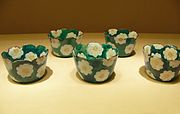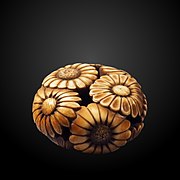Ogata Kenzan (尾形 乾山, 1663–1743), originally Ogata Shinsei (尾形 深省), and also known by the pseudonym Shisui, was a Japanese potter and painter.
Biography
[edit]Ogata Kenzan was born in Kyoto into a rich merchant family. His older brother was the painter Ogata Kōrin (1658–1716). Kenzan studied with the potter Nonomura Ninsei and made his own kiln. In 1712 a nobleman began patronizing his kiln, he moved to the east area of Kyoto. He was one of the greatest ceramicists of the Tokugawa era. He is associated with Kyō ware. In 1713, he moved to Edo where he also spent the rest of his life.
Ogata Kenzan produced a distinctive style of freely brushed grasses, blossoms, and birds as decorative motifs for pottery. His pieces were noted for their perfect relation between design and shape. He often collaborated on the decoration of pottery with his older brother, Ogata Kōrin, after whom the style known as Rinpa was named.
Bernard Leach, the British studio potter, wrote a book about Ogata Kenzan in 1966 entitled Kenzan and his Tradition, published by Faber & Faber in London.
Gallery
[edit]-
Container, earthenware, Edo period, first half of 18th century (Important Cultural Property)
-
Square dish with grapes that was exhibited at the 1873 Vienna World's Fair. It was later salvaged from the sunken ship Le Nil that was transporting it back to Japan.[1][2]
-
Five small glazed pottery bowls
-
Hanging scroll; ink, color, and gold on paper painting of evening glories
-
Netsuke depicting chrysanthemums
-
Autumn Ivy, after 1732
External links
[edit]![]() Media related to Ogata Kenzan at Wikimedia Commons
Media related to Ogata Kenzan at Wikimedia Commons
- Ogata Kenzan - Jyuluck-Do Corporation
- Pottery works by Ogata Kenzan
- Bowl with bamboo leaf design at Kimball Art Museum

![Square dish with grapes that was exhibited at the 1873 Vienna World's Fair. It was later salvaged from the sunken ship Le Nil that was transporting it back to Japan.[1][2]](https://upload.wikimedia.org/wikipedia/commons/thumb/a/a1/Tokyo_National_Museum_Japanese_ceramics_2018_%28012%29.jpg/180px-Tokyo_National_Museum_Japanese_ceramics_2018_%28012%29.jpg)




Well, that’s interesting to know that Psilotum nudum are known as whisk ferns. Psilotum nudum is the commoner species of the two. While the P. flaccidum is a rare species and is found in the tropical islands. Both the species are usually epiphytic in habit and grow upon tree ferns. These species may also be terrestrial and grow in humus or in the crevices of the rocks.
View the detailed Guide of Psilotum nudum: Detailed Study Of Psilotum Nudum (Whisk Fern), Classification, Anatomy, Reproduction